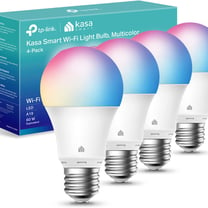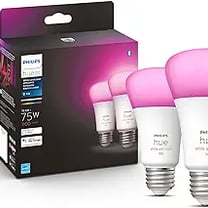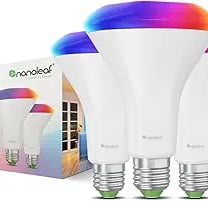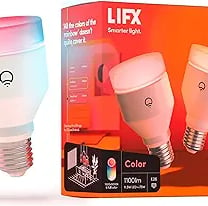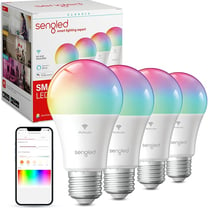Top Smart Lighting Solutions for Energy Efficiency in 2024
Discover the best smart lighting solutions for energy efficiency in 2024. Learn how innovative smart lights can reduce energy consumption, enhance your home's ambiance, and provide smart automation for a more convenient lifestyle. Explore the future of home lighting today!
9/11/20245 min read


Introduction:
Are you tired of seeing your energy bills inch higher every month? We’ve all been there, and honestly, it can get frustrating! But here’s the thing: you don’t have to settle for expensive electricity costs. With smart lighting solutions, you can dramatically reduce your energy consumption while keeping your home well-lit and eco-friendly.
Smart lighting isn’t just a fancy tech upgrade—it’s a smart move toward a more energy-efficient lifestyle. In fact, according to studies, pairing smart lights with energy-efficient LED bulbs can reduce your electricity usage by as much as 90%! That’s a huge difference over time.
And the best part? Smart lighting systems are easier to install and use than you might think. Whether you’re new to smart home lighting or just looking for a fresh upgrade, this guide will introduce you to the top smart lighting solutions for 2024. Ready to save energy and make your home smarter? Let’s dive in!
Why Smart Lighting is Key to Energy Efficiency
Smart lighting systems are a game-changer when it comes to energy efficiency. The beauty of smart lights is how they allow you to control your home’s lighting in ways that traditional lights just can't. Imagine your lights automatically dimming when it’s bedtime or turning off when no one’s in the room. That’s where smart technology shines—literally!
Here’s how smart lighting optimizes your energy use:
Automation and scheduling: Set your lights to follow specific schedules. Whether it’s turning off at sunrise or dimming after dinner, these customizations make sure you’re not wasting electricity.
Motion sensors: Smart lights can turn on or off based on movement in the room. No more forgetting to turn the lights off when you leave!
Dimming capabilities: Adjust the brightness depending on the time of day or mood. Dimmed lights use less energy, which means lower electricity costs.
By integrating energy-efficient smart lighting solutions into your home, you’ll not only reduce your carbon footprint but also see a noticeable difference in your energy bills. Who doesn’t want that?
Features to Look for in Energy-Efficient Smart Lighting Solutions
When choosing the right smart lighting solution, there are a few features to keep in mind to maximize both energy efficiency and convenience. Here’s a breakdown of what to look for:
LED Technology: One of the key factors in saving energy is pairing smart lights with LED bulbs. LED technology is known for its low energy consumption, and when combined with smart tech, it’s a powerful combo for reducing electricity usage.
Energy Monitoring: Some smart lighting systems come with built-in energy monitoring tools. These tools allow you to track how much electricity your lights are using, giving you insights into how you can save even more.
Voice Control: Integration with voice-activated systems like Amazon Alexa or Google Home can make managing your lighting even easier. Instead of getting up to turn off the lights, just ask your virtual assistant to do it for you.
Motion Detection: Smart lights with motion sensors can automatically turn on when you enter a room and off when you leave. This is especially useful for spaces like hallways, bathrooms, or garages, where lights are often left on by mistake.
Smart Home Integration: Many smart lighting solutions are compatible with broader smart home systems like Samsung SmartThings or Apple HomeKit. This integration allows you to control all your smart devices from one hub, making your home truly connected and efficient.
With these features in mind, you’ll be well on your way to making a smarter, greener choice for your home’s lighting system.
Top 5 Smart Lighting Solutions for Energy Efficiency in 2024
When it comes to choosing the best smart lighting solution for energy efficiency, there are plenty of great options. Here are the top 5 picks for 2024:
A powerhouse in the smart lighting market, Philips Hue offers a range of energy-saving features. With options for LED smart bulbs, customizable schedules, and motion sensors, this system can adapt to your home’s needs.
Integration with Google Home and Amazon Alexa makes it even easier to manage your lights. You can even dim the lights or change their colors using just your voice.
Philips Hue also provides energy monitoring through its app, helping you keep tabs on electricity usage.
Known for its high brightness and extensive color options, LIFX is another fantastic choice for energy-efficient smart lighting. Their app allows you to control lights remotely, schedule timers, and even track energy consumption.
These smart bulbs are bright but energy-efficient, making them ideal for homes looking to save on electricity without compromising on brightness.
Affordable and reliable, the TP-Link Kasa Smart Bulb offers great energy efficiency with advanced scheduling options and compatibility with Amazon Alexa and Google Assistant.
Its app tracks your electricity usage and suggests ways to reduce consumption, making it a smart choice for those new to energy-efficient lighting solutions.
If you’re looking for a more creative and visually striking lighting system, Nanoleaf Essentials is perfect. This eco-conscious lighting system is designed with energy-saving in mind and adds a touch of flair to any room.
With Apple HomeKit compatibility, you can control these smart LED lights with ease, making it both an eco-friendly and stylish option.
Sengled’s Smart Wi-Fi LED bulbs are packed with features, including motion sensors and dimming options. These bulbs automatically adjust brightness based on your activity, ensuring you’re not wasting energy when full brightness isn’t needed.
Integration with major smart home systems makes it easy to control and monitor.
How to Set Up Smart Lighting for Maximum Energy Savings
Setting up smart lighting can be a breeze if you follow a few simple steps. Here’s how to do it for maximum energy efficiency:
Choose the right spots: Focus on high-traffic areas where lights tend to stay on the longest. Installing smart lights in your living room, kitchen, and hallways can have the biggest impact on your energy bills.
Set up schedules: Using the app that comes with your smart lights, create schedules based on your daily routine. For example, have the lights dim automatically in the evening or turn off completely when you leave for work.
Use motion sensors: If you often forget to turn off lights, install smart bulbs with motion detection. These lights will automatically turn off when no one’s in the room, saving you energy without any extra effort.
Automate dimming: Bright lights aren’t always necessary, especially during the day. Automate dimming settings to adjust the brightness based on the time of day or the amount of natural light in the room.
By following these tips, you’ll optimize your smart lighting setup and maximize your energy savings.
Long-Term Benefits of Investing in Smart Lighting
Making the switch to smart lighting solutions isn’t just about immediate savings—it’s an investment in your home’s long-term efficiency and value.
Financial savings: Over time, energy-efficient smart lights will reduce your electricity usage, which means lower bills month after month. The initial cost of setting up a smart lighting system is easily offset by the long-term savings you’ll see on your electricity bills.
Environmental impact: Switching to energy-efficient lighting solutions reduces your home’s overall energy consumption, which in turn lowers your carbon footprint. This is an easy way to make your home more sustainable.
Home value: Smart home technology, including smart lighting, can increase the value of your home. If you’re planning to sell in the future, having a smart, energy-efficient home can make it more attractive to buyers.
Conclusion:
Investing in smart lighting solutions isn’t just about the convenience—it’s about making your home more efficient, saving money, and doing your part for the environment. Whether it’s installing motion-activated lights or optimizing brightness with smart LED bulbs, the right system can make a huge difference in how much energy your home uses.
Now it’s your turn to take action. Choose the best smart lighting solution for your home and start enjoying lower bills and a more eco-friendly lifestyle. Let’s light up a greener future together!
